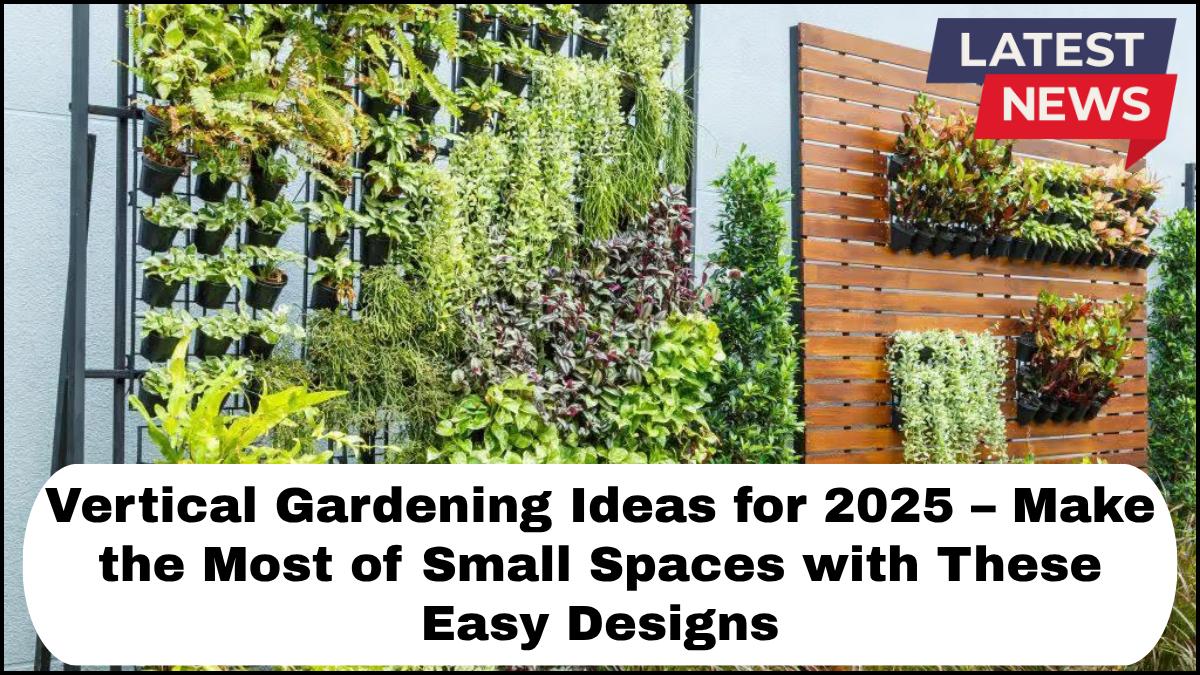Vertical gardening is no longer a niche trend—it’s a necessity for urban gardeners and a favorite technique for maximizing limited square footage. In 2025, with rising interest in eco-conscious living and functional aesthetics, vertical gardening ideas are evolving fast. Whether you’re working with a tiny balcony, a compact backyard, or just a sunny kitchen wall, there are smarter and more stylish ways than ever to grow up—literally.

Here are the best vertical gardening strategies for small spaces, along with practical tips to make each one work.
Vertical Pallet Gardens
Old wooden pallets have become go-to materials for small space gardening. They’re affordable, easy to find, and offer a ready-made structure for vertical planting. In 2025, designers are modifying pallets with built-in drip irrigation and detachable grow boxes.
How to Use:
-
Lean the pallet against a wall or fence.
-
Add landscaping fabric and staple it to create planting pockets.
-
Fill with herbs, leafy greens, or flowers.
Pro Tip: Paint or stain the pallet to weatherproof it and match your outdoor decor.
Modular Wall Planters
Modular vertical planters are one of the most flexible vertical gardening ideas on the market today. These stackable or linkable units allow you to scale your garden up or down based on space and plant type.
Best For: Apartments, balconies, kitchen walls.
Design Upgrade for 2025:
Look for modular systems with self-watering reservoirs and smart sensors that notify your phone when it’s time to water or feed your plants.
Hanging Pocket Organizers
A budget-friendly and space-saving method, hanging organizers—originally meant for shoes or accessories—are being reimagined as vertical planters. They’re perfect for small space gardening indoors or outdoors.
Setup:
-
Mount on a wall or over a balcony railing.
-
Fill each pocket with potting mix.
-
Plant herbs, strawberries, or succulents.
Pro Tip: Use felt or fabric that drains well and resists mold.
Trellis + Climbing Plants Combo
A trellis adds both beauty and functionality. It’s an ideal backdrop for climbing vegetables like beans, peas, and cucumbers or flowering vines like clematis and jasmine.
What’s New in 2025:
Modern trellises are being built with recycled composites and come with integrated grow lights for year-round cultivation—even indoors.
Ladder Gardens
Repurposing an old ladder into a tiered garden display is both rustic and space-savvy. Just add planks or trays to each rung and you’ve got a vertical growing station.
Perfect For: Small patios, entryways, or indoor corners with strong light.
Plant Suggestions:
-
Top tiers: herbs and greens.
-
Lower tiers: larger pots with bushy plants like basil or dwarf tomatoes.
Hydroponic Vertical Towers
For those who want efficiency and high yields, hydroponic towers are leading the way in 2025. These soil-less systems use water and nutrients to grow crops fast in a vertical format.
Benefits:
-
No soil = no mess.
-
Great for indoor or balcony use.
-
LED lighting ensures strong growth even in low-light areas.
Great For: Lettuce, kale, mint, and even strawberries.
Wall-Mounted Shelves with Grow Lights
If you’re serious about small space gardening indoors, consider installing tiered shelves fitted with grow lights. This lets you control the environment and maximize vertical space in kitchens, studios, or offices.
Extra Tip: Use smart timers to automate light cycles and simulate daylight.
Upcycled Furniture Gardens
Reclaim old dressers, bookshelves, or shoe racks as creative vertical gardens. Pull out drawers to create staggered planting areas or stack shelves for a lush green wall.
Add-ons for 2025:
-
Attach moisture sensors.
-
Use recycled water catchment systems.
Frequently Asked Questions (FAQs)
Q1: What are the advantages of vertical gardening in small spaces?
A: Vertical gardening saves ground space, improves air circulation, makes harvesting easier, and adds aesthetic appeal to otherwise unused areas like walls and fences.
Q2: What plants are best suited for vertical gardens?
A: Herbs (basil, thyme), leafy greens (lettuce, spinach), small vegetables (cherry tomatoes, radishes), strawberries, and climbing plants (beans, peas) are excellent choices.
Q3: Can I create a vertical garden indoors?
A: Absolutely. Use shelves, hanging organizers, or hydroponic towers. Just ensure you have adequate lighting—natural or supplemented with grow lights.
Q4: How do I maintain a vertical garden?
A: Water regularly (consider drip systems for ease), check for pests, and ensure the structure supports the weight of your plants and soil.
Q5: Is vertical gardening expensive?
A: Not necessarily. You can upcycle materials like pallets, ladders, and old furniture. Advanced systems like hydroponic towers cost more but offer higher yields and cleaner setups.
click here to learn more